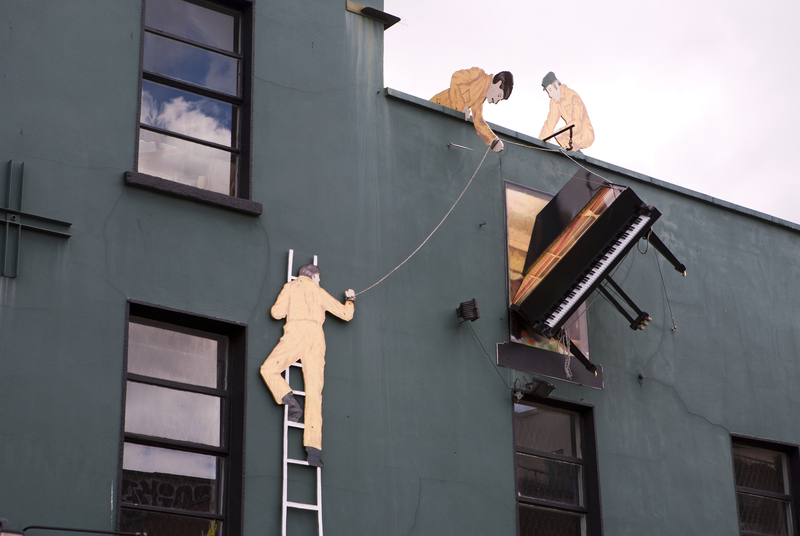Avoiding DIY Disasters: The Expertise Needed for Safe Piano Moving
Posted on 29/06/2025
Avoiding DIY Disasters: The Expertise Needed for Safe Piano Moving
Relocating a piano, whether within your home or across cities, is no ordinary moving task. Pianos are more than just large pieces of furniture; they are intricate, delicate instruments that require specialized handling. Avoiding DIY disasters during piano moving boils down to one essential factor: expertise. In this comprehensive article, we delve into the dangers of moving a piano yourself, the skills professionals bring to the table, and why safeguarding your instrument -- and your safety -- means entrusting the job to experts.

Why Moving a Piano Is Not a Simple Task
If you're considering a DIY piano move, you must first understand what sets pianos apart from other heavy objects:
- Weight Distribution: Pianos are notoriously heavy, sometimes weighing over 1,000 pounds. Their weight is not evenly distributed, making them awkward and unpredictable to carry.
- Fragility: Despite their size, pianos are delicate instruments. Their internal components include fine strings, hammers, and soundboards that can be irreparably damaged by improper handling.
- Shape and Size: Grand, baby grand, and upright pianos each pose unique logistical challenges. Their bulkiness often requires advanced maneuvering.
Moving a piano without the right expertise can result in not only catastrophic damage to the instrument, but also serious personal injury and property damage.
The High Cost of DIY Piano Moving Mistakes
Many homeowners are tempted to save money by moving a piano themselves, but DIY disasters can be costly and dangerous. Here are some of the risks associated with taking on piano moving without professional help:
- Instrument Damage: Incorrect lifting and moving can crack the frame, warp the soundboard, or snap the strings - all potentially ruinous to a piano's acoustics.
- Injury to Movers: Without proper technique and equipment, severe back injuries, crushed fingers, and more serious accidents can occur.
- Property Damage: Scratched floors, broken banisters, dented walls, and damaged doorways are all too common when pianos are dragged, dropped, or forced through tight spaces.
- Expensive Repairs: Fixing damaged pianos or homes often far exceeds the cost of hiring professionals in the first place.
- Loss of Value: Even minor exterior blemishes can reduce the value of your piano, particularly if it's a family heirloom or antique.
Real-Life DIY Disasters
From pianos tumbling down stairs to being stuck in doorways, the internet is full of piano moving horror stories. These unfortunate events showcase exactly why expertise is essential for safe piano transport.
What Does a Professional Piano Mover Bring to the Table?
What separates a seasoned piano mover from a group of enthusiastic -- but untrained -- friends? Skill, experience, and the right gear make all the difference:
- Specialized Training: Professional movers understand the mechanics of each piano type.
- Proper Equipment: Movers use piano skids, moving blankets, ramps, moving dollies, and straps specifically designed for piano moving.
- Damage Prevention Techniques: Wrapping and securing parts, measuring pathways, and dismantling where necessary ensures both home and instrument remain intact.
- Insurance Coverage: Reputable movers are insured so you're protected against mishaps -- something DIY movers certainly cannot guarantee.
Piano moving professionals also have experience navigating tricky logistics -- from narrow hallways and spiral staircases to elevators and multi-story apartments.
Preparing for a Safe Piano Move: What You Need to Know
Planning the Move
Before a piano can be moved, meticulous planning is required. Here are critical steps:
- Assess the Environment: Measure all doorways, hallways, staircases, and elevators along the route.
- Clear Obstacles: Remove rugs, decor, and other items to create a clear pathway.
- Understand the Destination: Ensure your piano will fit comfortably in its new home, both physically and aesthetically.
Tools and Equipment Used by Professionals
Part of making piano moving safe is using the right equipment. Professional movers utilize:
- Piano Dollies and Skids: These distribute weight and allow secure rolling.
- Padded Blankets: Prevent scratches and absorb shocks.
- Straps and Harnesses: Keep the piano stable and balanced during lifting.
- Ramps: Help in negotiating stairs and curbs safely.
The Expertise Needed for Safe Piano Moving
Skills and Knowledge Required
To avoid disastrous outcomes, the people moving your piano must possess:
- Lifting Techniques: Knowing how to evenly distribute weight and prevent tipping or dropping.
- Instrument Anatomy: Understanding which parts can be safely disassembled for easier transport.
- Spatial Awareness: Ability to judge angles, clearances, and movement through complex spaces.
- Team Coordination: Moving a piano is a well-choreographed operation -- clear communication is key.
Why Trusting Professionals Is Recommended
Professional piano movers are adept at handling both expected and unexpected challenges. From navigating tight corners to overcoming sudden obstacles, their expertise minimizes risk at every step. When it comes to moving pianos, the difference between a successful move and a costly disaster truly is knowledge and experience.
DIY Piano Moving: When Might It Be Safe?
There are rare cases when moving a small upright piano short distances inside a home, with adequate help and equipment, may be achievable. If you choose to attempt this, consider the following vital tips:
- Never Move Alone: Always have at least three or four strong adults to assist.
- Use Proper Equipment: Rent professional-grade moving dollies, straps, and padding.
- Disassemble Where Possible: Remove parts such as pedals, music stands, or even legs for grand pianos under supervision from a technician.
- Protect Pathways: Place temporary floor protection to guard against scratches and dents.
- Lift, Don't Drag: Always lift the piano fully to avoid breaking legs or damaging floors.
Warning: Even with these precautions, piano moving is never risk-free. If at any point it feels unsafe, stop and call a professional.
The Benefits of Hiring Professional Piano Movers
Why should you hire a piano moving expert? Let's break down the key advantages:
- Safety: Protects both the movers and your property from injury and damage.
- Specialization: Experienced movers have likely encountered -- and solved -- every possible piano moving issue.
- Insurance: Professional piano moving companies carry insurance for peace of mind.
- Efficiency: Moving is completed quickly, minimizing the time your piano is at risk.
- Post-Move Support: Professionals can advise on tuning needs after a move and help with setup in the new location.
In addition, expert piano movers often offer climate-controlled transport and storage, vital for protecting valuable or antique instruments from environmental damage.

Frequently Asked Questions About Piano Moving
Can All Movers Handle Pianos?
Not all moving companies are equipped or insured to handle pianos. Always verify a mover's experience, credentials, and insurance coverage before booking.
How Much Does Professional Piano Moving Cost?
The cost of safe piano relocation varies by piano type, moving distance, complexity, and obstacles such as stairs. While it's more expensive than DIY, the cost of preventing damage or injury is usually far less than the price of repairs or medical bills.
Will My Piano Need to Be Tuned After Moving?
Almost always, yes. Even with the most careful moving, a piano's internal components can shift slightly, affecting its tone. Wait a couple of weeks for the piano to acclimate before calling a tuner.
Can a Piano Be Stored During a Move?
Yes, but make sure it's in a climate-controlled facility that protects against humidity and temperature fluctuations.
Conclusion: Prioritize Expertise for Safe, Stress-Free Piano Moves
In summary, avoiding DIY disasters when moving a piano comes down to recognizing the limits of enthusiasm and strength alone. Piano moving requires experience, proper equipment, coordination, and care -- qualities best found in professionals. While the cost may seem daunting, the risks of injury, damage, and loss of value make skimping a dangerous gamble.
Above all, treat your piano with the respect it deserves. Entrust its next move to those with the skills and expertise to deliver it safely to its new home.
Key Takeaways for Safe Piano Moving:
- Never underestimate the challenges of moving a piano.
- Understand that both the instrument and your safety are at risk during DIY attempts.
- Know that professional piano movers are trained, insured, and experienced for a reason.
- Save yourself the stress, expense, and potential heartache -- hire the experts!
For safe piano moving, combining knowledge, preparation, and expertise isn't just beneficial; it's essential.



